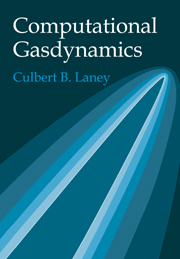Book contents
- Frontmatter
- Contents
- Preface
- Chapter 1 Introduction
- Part I Gasdynamics Review
- Part II Computational Review
- Part III Basic Principles of Computational Gasdynamics
- Chapter 11 Conservation and Other Basic Principles
- Chapter 12 The CFL Condition
- Chapter 13 Upwind and Adaptive Stencils
- Chapter 14 Artificial Viscosity
- Chapter 15 Linear Stability
- Chapter 16 Nonlinear Stability
- Part IV Basic Methods of Computational Gasdynamics
- Part V Advanced Methods of Computational Gasdynamics
- Index
Chapter 13 - Upwind and Adaptive Stencils
Published online by Cambridge University Press: 07 December 2009
- Frontmatter
- Contents
- Preface
- Chapter 1 Introduction
- Part I Gasdynamics Review
- Part II Computational Review
- Part III Basic Principles of Computational Gasdynamics
- Chapter 11 Conservation and Other Basic Principles
- Chapter 12 The CFL Condition
- Chapter 13 Upwind and Adaptive Stencils
- Chapter 14 Artificial Viscosity
- Chapter 15 Linear Stability
- Chapter 16 Nonlinear Stability
- Part IV Basic Methods of Computational Gasdynamics
- Part V Advanced Methods of Computational Gasdynamics
- Index
Summary
Introduction
This chapter describes the basic principles of stencil selection. To keep the discussion to a reasonable length, the focus will be on explicit finite-difference methods, except for the last section, which concerns explicit finite-volume methods. Some methods blindly choose the same stencil regardless of circumstances, including the nine simple methods seen in Chapter 11. However, this naive simplicity exacts a toll on accuracy, stability, or both. This chapter introduces methods with adjustable stencils, also called adaptive or solution-sensitive stencils. This chapter provides only an introduction; a full account will have to wait until later, especially Chapter 18 and Part V.
The governing principles of adjustable stencil selection are as follows:
The numerical domain of dependence should model the physical domain of dependence. For example, the physical domain of dependence always lies entirely upwind; in other words, the physical domain of dependence lies to the right for left-running waves and to the left for right-running waves. Upwind stencils model this physical behavior by using only upwind points or, at least, more upwind than downwind points. However, in some cases, centered methods using equal numbers of upwind and downwind points actually model the physical domain of dependence better than upwind methods, as discussed below. Even downwind-biased stencils may provide good enough modeling, providing that they contain at least one upwind point; as seen in the last chapter, the CFL condition requires that every stencil contain at least one upwind point.
The numerical domain of dependence should avoid shocks and contacts whenever possible. As seen in Part II, jump discontinuities can severely disrupt the component approximations, and the combinations used in computational gasdynamics sometimes further magnify the disruption.
- Type
- Chapter
- Information
- Computational Gasdynamics , pp. 222 - 248Publisher: Cambridge University PressPrint publication year: 1998

